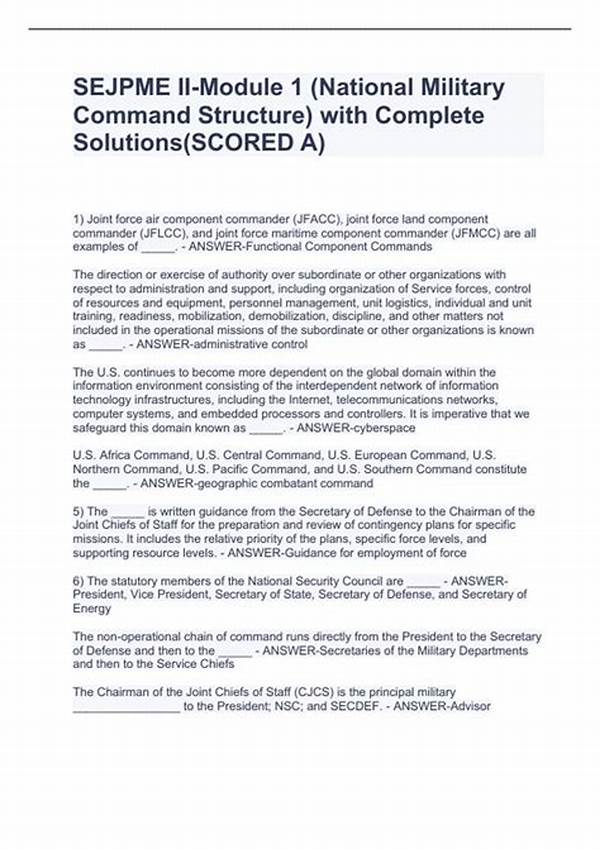In today’s interconnected world, military collaborations between nations have become increasingly critical. As threats transcend borders, the need for efficient and standardized communication between international military forces has ramped up. Cross-national military command protocols are designed to facilitate cooperation and operational efficiency among allied nations. These protocols serve as codified procedures that ensure clarity, compliance, and coordination when multiple national forces operate together, especially in high-stakes environments. Understanding these protocols is fundamental not only to maintain harmony but also to address global security challenges collectively.
Importance of Cross-National Military Command Protocols
Cross-national military command protocols are foundational to modern military alliances, as they dictate the collaborative and operational frameworks between partnering nations. These protocols outline the necessary procedures and guidelines for joint missions, ensuring that all participating forces can work seamlessly towards common objectives. They involve the establishment of unified communication channels, standard operating procedures, and coordinated strategies. Without such protocols, there could be confusion, delays, and potential conflict among friendly forces, which can jeopardize mission success. The significance of these protocols is not merely operational but also strategic, as they foster trust and reliability among nations, strengthening global alliances. Through meticulous planning and adherence to these protocols, nations can enhance their collective security posture and response capabilities, thereby mitigating threats more effectively.
Components of Cross-National Military Command Protocols
1. Communication Standards: Essential for mutual understanding, communication standards within cross-national military command protocols ensure that all forces remain synchronized and informed.
2. Standard Operating Procedures (SOPs): These are vital elements that guide joint operations, providing a universal approach that all involved parties must follow.
3. Training and Exercises: Regular training and exercises are embedded within these protocols, allowing forces to prepare and refine joint strategies and responses to potential threats.
4. Rules of Engagement: Clear and mutually agreed upon rules of engagement prevent tactical missteps and guarantee coordinated actions during operations.
5. Command Hierarchy: Establishing a transparent command hierarchy is crucial to these protocols, as it defines the roles and responsibilities of each participating nation’s forces.
Operational Frameworks in Cross-National Military Command Protocols
The operational frameworks embedded in cross-national military command protocols provide a structured approach to multinational military cooperation. Such frameworks include comprehensive planning documents, shared intelligence protocols, and logistical coordination. By integrating these elements, these protocols ensure a cohesive operation across different national military units, establishing a unified front against threats. They also allow for resource optimization, where assets from various nations can be pooled for maximum efficacy. These frameworks are continually updated to adapt to emerging challenges and ensure operational readiness. This adaptability is crucial, given the dynamic nature of global security threats. Furthermore, the operational frameworks provide guidelines for post-operation evaluations, enabling participating forces to learn and evolve from joint mission experiences.
Challenges in Implementing Cross-National Military Command Protocols
1. Cultural Differences: Diverse military cultures and operational doctrines can pose challenges in aligning cross-national military command protocols.
2. Technology Integration: Ensuring compatible technological systems among different nation’s forces can be an impediment for streamlined communication and operations.
3. Political Dynamics: Shifting political landscapes can impact the willingness or commitment of nations to adhere to established protocols.
4. Resource Allocation: Balancing resource contributions among nations can create friction and requires careful negotiation.
5. Legal Frameworks: Variations in national legal frameworks may complicate the implementation of cross-national military command protocols.
6. Language Barriers: Effective communication is paramount, and language differences can create obstacles in ensuring clarity and efficiency.
7. Trust Building: Developing and maintaining trust among nations is critical for the success of these protocols but can be a complex, ongoing task.
8. Cybersecurity Threats: Establishing protected communication channels is a priority amidst escalating cyber threats.
9. Bureaucratic Hurdles: Navigating through the bureaucratic processes of multiple nations can delay protocol implementations.
10. Dynamic Threats: The ever-evolving nature of global threat landscapes necessitates continuous protocol updates and adaptability.
Adaptability and Evolution of Cross-National Military Command Protocols
Cross-national military command protocols are not static; they must continually evolve to address emerging challenges and incorporate technological advancements. As global threats become more sophisticated, these protocols are re-evaluated and revised to bolster their effectiveness. This adaptability ensures that cooperation among allied nations remains robust and relevant. Factors such as cyber warfare, non-state actors, and asymmetric threats prompt ongoing assessments and updates to existing protocols. The emphasis is placed on flexibility, allowing protocols to incorporate novel strategies, tactics, and technologies while fostering resilience against unforeseen challenges. The collaborative efforts in updating these protocols signify the unified intent of nations to address global security issues proactively and decisively.
Future Prospects of Cross-National Military Command Protocols
Looking forward, cross-national military command protocols will likely broaden their scope to encompass emerging domains such as space and cyber warfare. As technological innovations outpace traditional strategies, these protocols will need to integrate cutting-edge technologies, ensuring continued effectiveness and security. International collaboration in research and development will drive protocol advancements, fostering innovative solutions to complex security challenges. Furthermore, enhancing interoperability among different military systems will become a focal point, solidifying alliances and ensuring collective security. As nations recognize the value of cross-national military efforts, these protocols will become increasingly sophisticated, providing a crucial foundation for maintaining global peace and stability.
Summary of Cross-National Military Command Protocols
Cross-national military command protocols play an indispensable role in modern defense strategies. By establishing standardized procedures for multinational military cooperation, they enable seamless collaboration among allied forces. These protocols address crucial areas such as communication, command hierarchy, operational frameworks, and training, ensuring collective readiness and strategic alignment. Addressing barriers such as cultural differences and technological disparities is pivotal to the effective implementation of these protocols. However, with the increasing complexity of global threats, these protocols are expected to evolve, adapting to innovative technologies and emerging domains. The cross-national military command protocols provide a pathway for nations to unite against shared threats, thereby enhancing global security. As they continue to advance, these protocols ensure that military alliances remain resilient, agile, and equipped to safeguard international peace and stability.





